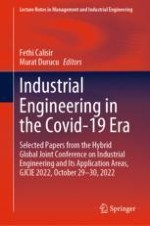2023 | Buch
Industrial Engineering in the Covid-19 Era
Selected Papers from the Hybrid Global Joint Conference on Industrial Engineering and Its Application Areas, GJCIE 2022, October 29-30, 2022
herausgegeben von: Fethi Calisir, Murat Durucu
Verlag: Springer Nature Switzerland
Buchreihe : Lecture Notes in Management and Industrial Engineering
